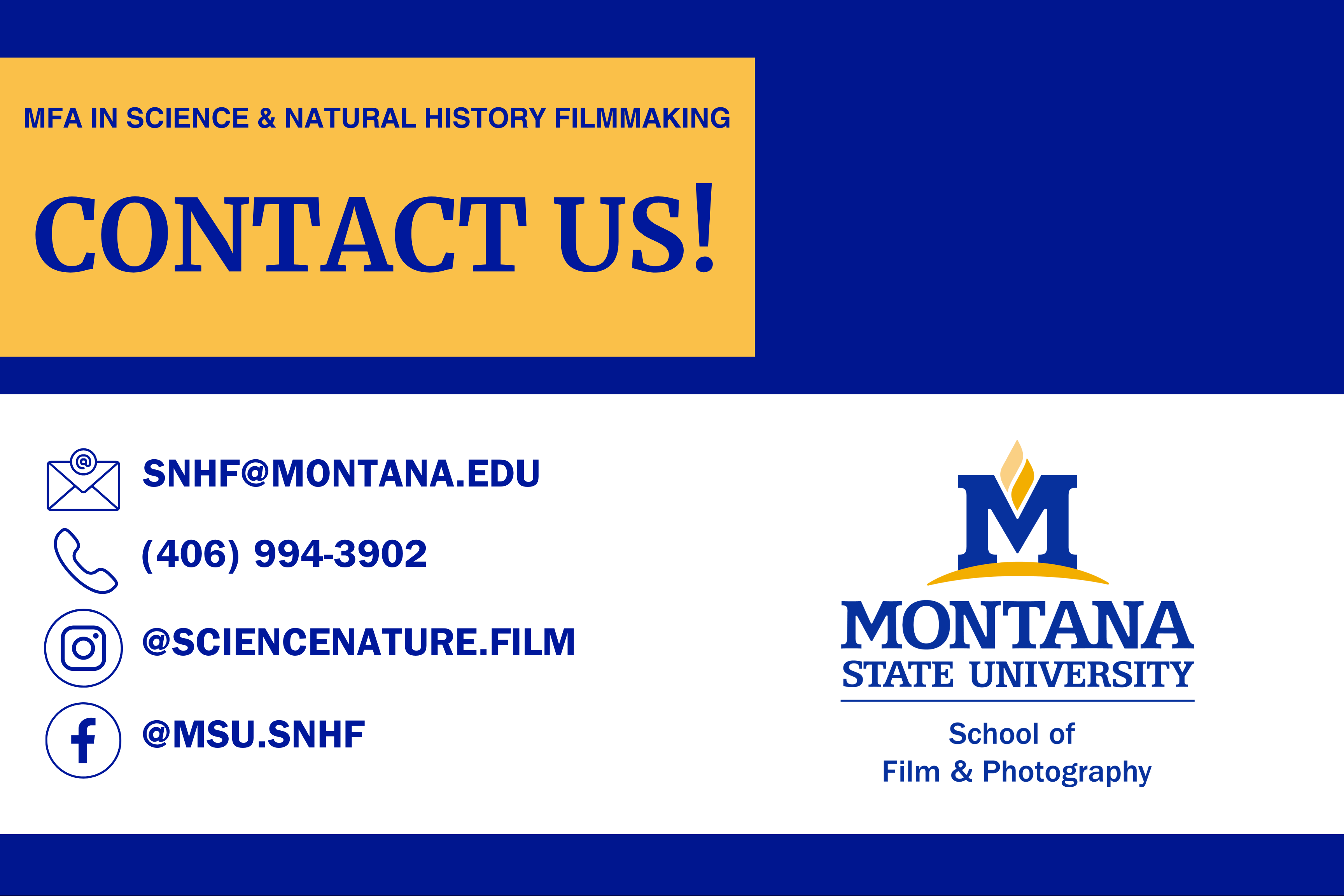Frequently Asked Questions (FAQs)
The mission of the Montana State University MFA in Science and Natural History Filmmaking (SNHF) is to train students with formal education and experience in science, engineering, or technology to become filmmakers. The SNHF program seeks to educate generations of filmmakers who have the knowledge needed to create accurate, innovative, and memorable programs and media that advance the public understanding of science in all its many manifestations.
Unlike a typical graduate program, virtually no two students in the SNHF will have the same educational background. This diversity of previous training makes for a thriving and organic interdisciplinary environment. The SNHF believes that through intense training, truly original perspectives, and an understanding of the infinite possibilities of experience, our students can master the past, capture the present, and create the future of science and natural history media.
Science communication has become a public concern because scientific understanding affects so many areas of contemporary life including health, the environment, space, natural resource preservation, and wildlife habitat, We are the only M.F.A. program offering in-depth training in producing media related to all these critical fields of information.
Modern media creation requires the knowledge of film, video, digital media, computers, the Internet, and the Cloud. It also necessitates a knowledge of media theory and presentation strategies along with an understanding of a film and media history. You will study all these subjects as well as the ones you probably expect (writing, editing, directing, cinematography) and a few you might not (information technology, contemporary trends, and digital perception). Your thesis work includes both a written thesis and a thesis film. For an overview of the three-year curriculum, please review the Cohort 19 Handbook.
Bozeman is a vibrant, modern city of approximately 45,000 tucked in a valley bordered by three Rocky Mountain ranges. Home to several dozen conservation and outdoor recreational organizations as well as to Montana State University, Bozeman is a short distance from Yellowstone National Park, the headwaters of the Missouri River, Hyalite Canyon, and both the Bridger and Big Sky ski areas, The area combines the intellectual and artistic stimulation of a Carnegie 100 research university town with the many outdoor opportunities of a recreational hub.
Our graduates successfully pursue careers in broadcast, cable and web production, government and NGO work, museum exhibition, freelance videography, website/interactive/mobile design, and teaching. Montana State MFAs in SNHF work for, among others, National Geographic Television, NASA, the National Park Service, NOAA, the BBC, public television, leading museums, science-related foundations, aquariums, and several universities.
Currently we do not, but prospective students are still encouraged to schedule a private visit whenever it suits their schedule. Individuals considering applying to the program can visit the School of Film and Photography to check out production equipment and facilities, meet with current faculty and students, and ask questions in person about the program.
The SNHF program is located in the Visual Communications Building (VCB) on Montana State University's campus. Students have access to a dedicated graduate student edit bay including computers running Pro Tools, the Adobe Creative Cloud, and other top-rated production software. Students also have access to a wide array of industry quality production equipment in the School of Film and Photography's Equipment Checkout. HD cameras, hard-disc sound recorders, boom mics, long lenses, and industry standard tripods are all available to enrolled students. There are also two permanent soundstages in the VCB. Although the Program does not require equipment ownership, many students choose to buy their own cameras to enjoy increased availability and usage flexibility. Most students also own laptop computers and use them for note taking, research, and papers as well as for field downloading of camera memory cards and editing.
Students live in a variety of housing situations. Graduate Student Housing offers a range of options from modern dormitories (often with meal plans) to family housing apartments. Other options include private apartment rentals, shared leased housing, and other types of student accommodations in the surrounding community. For more information about available housing, please contact the Office of Family and Graduate Housing http://www.montana.edu/fgh/.
Students in the SNHF program have a wide variety of backgrounds in the sciences and other fields. Our students include Ph.D.'s, M.D.'s and D.V.M.'s, recent bachelor degree graduates, marine biologists, neuroscientists, Marine Biologists to Ph.D. neuroscientists, biologists, physicists, geologists, and ecologists. They come from throughout the United Sates and many other countries including Canada, Colombia, Spain, Sweden, and the U.K.
Yes. Students are required to complete at least one internship during their SNHF careers. Our students have worked at internships with many organizations that range from production organizations (National Geographic, Animal Planet), conservation and advocacy groups (WITNESS), educational foundations (The PAST Foundation), and government agencies (National Science Foundation). There is a strong demand for our student interns in the general production community.
The SNHF program requires either a major or minor in a scientific field. The Program accepts a broad definition of "hard" (biology, chemistry, physics, geology, etc.), "applied" sciences (environmental science, ecology, medicine) and social sciences (psychology, sociology, etc.). Career or other practical experience with science media, such as public television programming or industrial films, may also meet the qualification requirement. Prospective students who are not certain they meet this requirement should contact the program at snhf@montana.edu and request a transcript or c.v. review.
Admission procedures can be found on the Application Tab above. Admission is through The Graduate School with a specification for the SNHF program. Along with The Graduate School university requirements, The SNHF program requires these additional supporting materials: 1) a resume/c.v.; 2) A personal statement outlining your personal objectives in pursuing the MFA; and 3) three letters of recommendation. Submission of videos, still photographs, and other creative work is optional.

